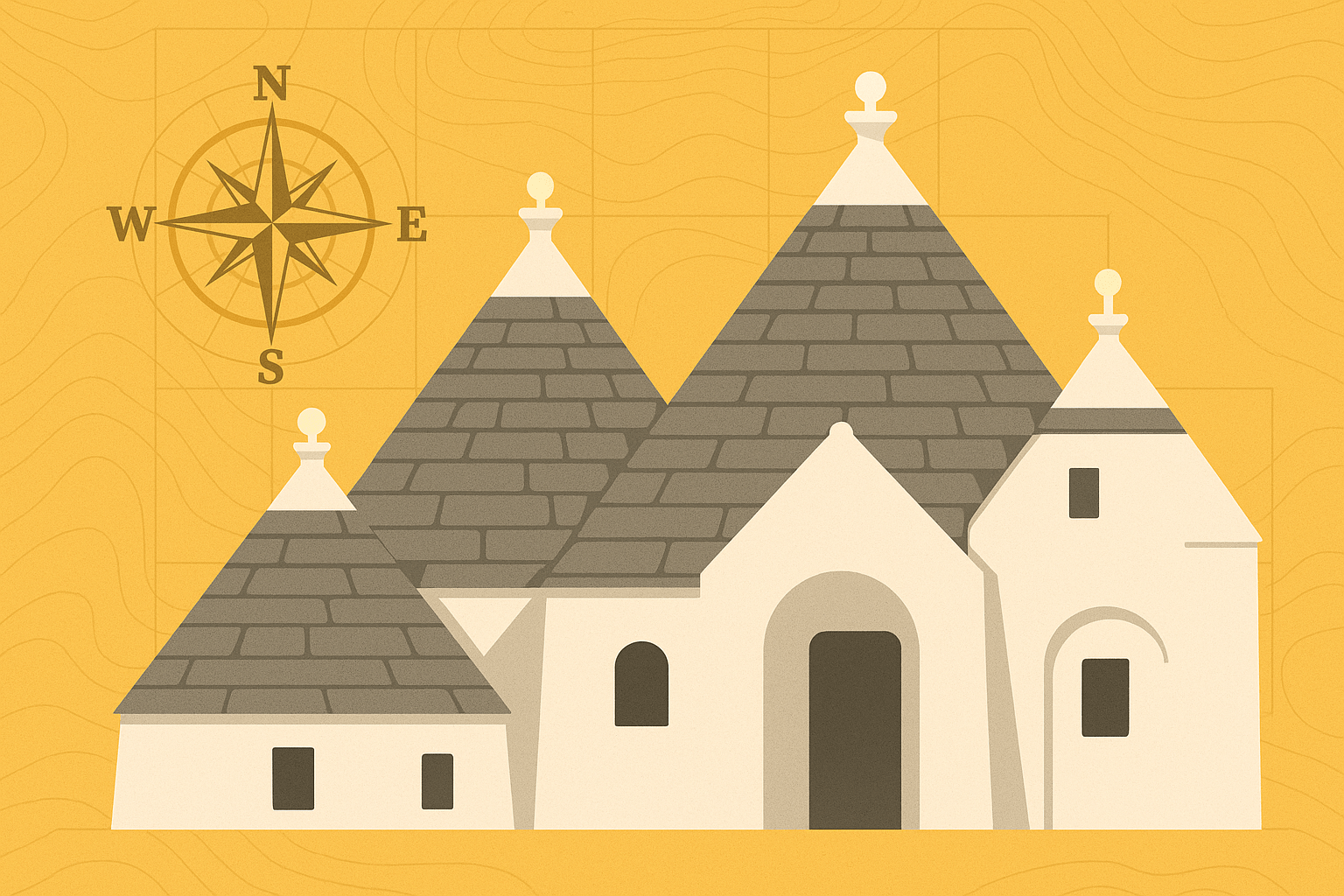A Landscape Carved from Limestone
To understand the trulli, you must first understand the ground beneath them. Puglia, particularly the Murgia plateau where the Itria Valley lies, is a karstic landscape. This means the region is dominated by soft, porous limestone that has been shaped by water over millennia, creating a gentle, rolling terrain of sinkholes and caves. More importantly, this geology provided an almost inexhaustible supply of the perfect building material: limestone.
Farmers clearing the land for agriculture, especially for olive groves and vineyards, would unearth vast quantities of this sedimentary rock. The stone naturally fractures into flat, stackable slabs. Instead of being a nuisance, this surplus stone became a resource. It was the raw material, freely available and perfectly suited for a unique construction method that would come to define the entire region.
The Architecture of Necessity: How to Build a Trullo
A trullo is a masterful example of vernacular architecture—a design born not from an architect’s blueprint but from local needs, materials, and traditions. The construction is deceptively simple yet brilliantly effective, a direct response to the physical environment.
Dry-Stone Walls and Double-Skinned Roofs
The most defining feature of a trullo is its “a secco” or dry-stone construction. The thick, circular walls and the signature conical roof are built without any mortar or cement. Stones are simply stacked with remarkable precision. This technique was only possible because of the specific quality of the local limestone.
The conical roof is an engineering marvel. It’s built with two layers:
- The Inner Layer: A dome-like vault of wedge-shaped stones, called candelé, that push against each other to create a strong, self-supporting structure.
- The Outer Layer: A waterproof cone made of flat limestone tiles, called chiancarelle, angled downwards to shed rainwater efficiently. In a region where rain is precious and the karstic ground quickly absorbs it, this design allowed for the collection of water into cisterns dug beneath the house.
The thick stone walls and double-layered roof also create a brilliant form of natural insulation. They keep the interior cool during Puglia’s scorching summers and retain warmth during the milder winters, a perfect solution for the Mediterranean climate.
The Whitewash and the Pinnacle
The brilliant white of the trulli walls isn’t just for aesthetics. The walls are coated in a lime wash, which serves two key geographical purposes. First, the white surface reflects the intense southern sun, helping to keep the building’s interior temperature comfortable. Second, lime has natural antiseptic properties, promoting hygiene within the home.
Crowning each roof is a decorative pinnacle, or pinnacolo. These were often the “signature” of the master builder (trullaro) who oversaw the construction. Their shapes vary from simple spheres and discs to more elaborate crosses, stars, or symbolic figures, adding a touch of individuality to each home.
A Story of Tax Evasion: The Human Geography of the Trulli
While the physical geography provided the “how”, it was human geography—specifically politics and economics—that provided the “why.” The proliferation of trulli in the 17th and 18th centuries is a fascinating tale of peasant ingenuity and rebellion against feudal authority.
At the time, the region was under the control of the Kingdom of Naples. A royal edict, the Pragmatica de Baronibus, levied heavy taxes on any new, permanent settlement. To develop their lands without incurring these crippling fees, local feudal lords, like the Counts of Conversano who ruled the area around Alberobello, came up with a clever workaround. They encouraged peasants to build their homes using the dry-stone method.
Why? Because a structure built without mortar was not considered “permanent.” The design was such that by removing a single keystone, the entire conical roof would collapse into a manageable pile of rocks. When the king’s tax collectors were spotted on the horizon, a warning would go out, and in a matter of hours, an entire village could be reduced to heaps of stone, appearing as nothing more than temporary agricultural shelters. Once the taxman left, the homes were rebuilt just as quickly. The trullo, therefore, is an architectural symbol of defiance—a house designed to disappear.
Alberobello: A Trulli Capital and UNESCO World Heritage Site
Nowhere is the legacy of the trulli more breathtakingly preserved than in the town of Alberobello. Declared a UNESCO World Heritage Site in 1996, the town boasts over 1,500 trulli concentrated in two historic districts.
- Rione Monti: The larger, more famous district, with streets lined with trulli that now house artisan shops, cafes, and souvenir stores.
- Aia Piccola: A quieter, more authentic quarter where many trulli are still inhabited by locals, offering a glimpse into the living history of this unique urban landscape.
Look closely at the roofs in Alberobello, and you might see mysterious white symbols painted on the chiancarelle. These symbols are a mix of Christian (crosses, hearts pierced by an arrow representing Mary), pagan (zodiac signs), and primitive good-luck charms, meant to protect the family within from evil spirits.
The Trulli Today: From Humble Hut to Chic Retreat
The very features that once marked the trulli as housing for the poor—their small size and “impermanence”—have fueled their modern revival. The threat of the tax collector is long gone, and today these structures are celebrated as a cherished part of Puglia’s cultural identity.
Many have been painstakingly restored, their stone walls and conical roofs now sheltering boutique hotels, charming bed-and-breakfasts, and exclusive holiday villas. Tourists flock from around the world to experience sleeping in a trullo, connecting with a building form that is a perfect, tangible expression of its environment. The trullo has transformed from a symbol of peasant hardship into a driver of the regional economy, proving that the most authentic stories, written in the very stone of the earth, have enduring power.
